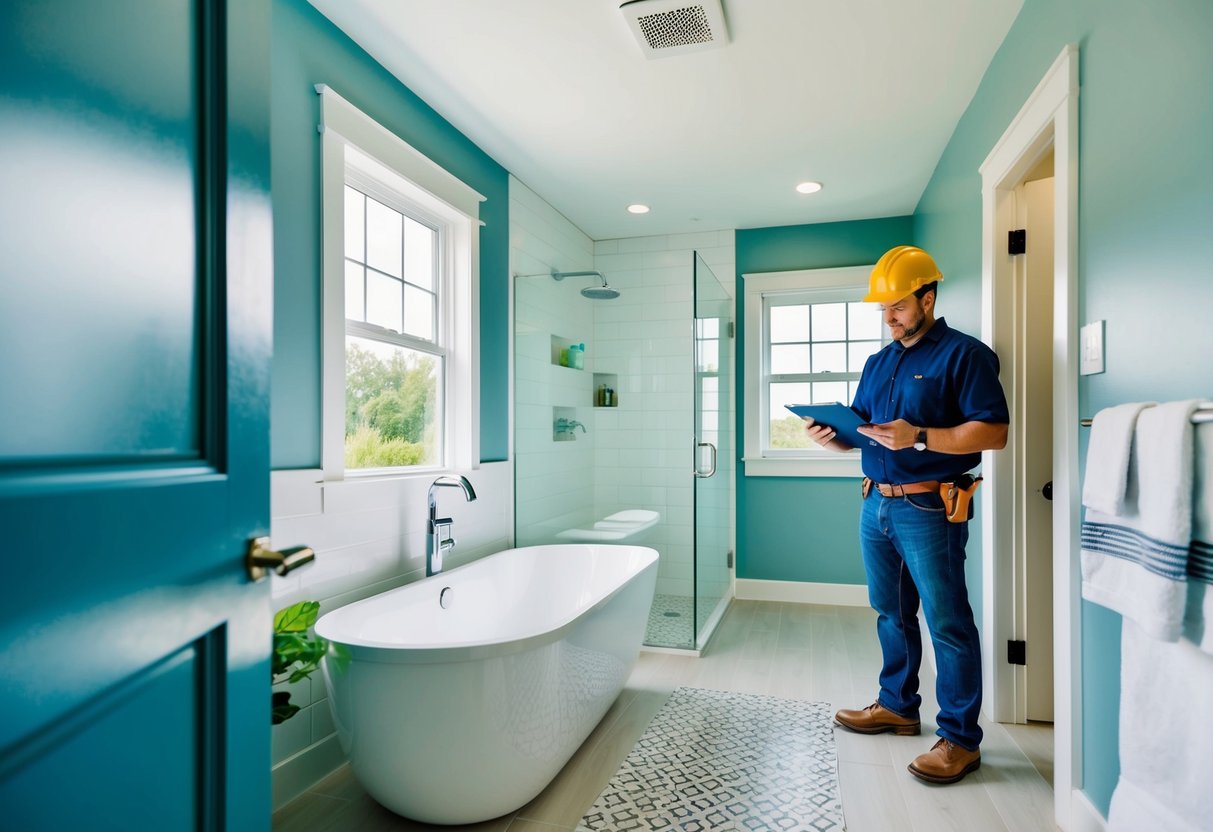Renting out a room in Australia can be tricky if you’re a tenant yourself.
Many renters wonder if they can sublet a spare room to earn extra income. The answer depends on your lease agreement and local laws, but it’s often possible with your landlord’s permission.

Before you start looking for a flatmate, check your rental contract carefully.
Some leases forbid subletting outright, while others may allow it with the owner’s okay. If subletting isn’t mentioned, you’ll need to ask your landlord. They might agree if you explain your plans and show you’ll be responsible.
Even with approval, there are important things to think about.
You’ll need to declare any rent as income on your taxes. You should also look into insurance to protect yourself and your belongings. Picking the right person to share your home is crucial too.
Key Takeaways
- Check your lease and get landlord approval before subletting a room
- Declare rental income on your taxes and consider extra insurance
- Choose flatmates carefully to ensure a positive shared living situation
Understanding Your Rights and Responsibilities

Renting out a room in Australia involves key legal and practical considerations. You need to be clear on your role and obligations to avoid potential issues.
Landlord vs. Sublessor: Legal Distinctions
When you rent out a room in a property you’re leasing, you become a sublessor. This means you take on some landlord duties for your subtenant.
You’re responsible for providing a safe, habitable space and respecting your subtenant’s right to quiet enjoyment.
You must get written permission from your landlord before subletting. Check your lease agreement – it may have clauses about subletting. If allowed, you’ll need to create a written agreement with your subtenant.
Remember, you’re still accountable to your landlord for the whole property. Any damage or issues caused by your subtenant are your responsibility.
Tenant Agreement: Navigating the Lease Terms
Your subtenant agreement should clearly spell out rights and responsibilities.
Include details on rent, bond, bills, use of common areas, and house rules.
Set clear expectations about visitors, noise levels, and cleaning shared spaces. Decide how you’ll handle conflicts or breaches of the agreement.
Make sure your subtenant understands they don’t have the same rights as a tenant dealing directly with a landlord. Their agreement is with you, not the property owner.
Keep records of all payments and communications. This can help if disputes arise later. Be fair and reasonable in your expectations, but don’t forget you’re ultimately responsible for the property.
Financial Considerations of Renting Out a Room

Renting out a room in your home can boost your income, but it comes with financial responsibilities. You need to think about potential earnings and costs.
Calculating Potential Rental Income
To work out how much you can earn, look at similar room rentals in your area.
Check websites and local listings to get an idea of rates. Think about what your room offers – size, amenities, and location all affect the price.
Remember, rental income is taxable. You must report it on your tax return, even if it’s just from one room. Keep good records of all rent you receive. This includes bond money and fees from cancelled bookings.
Budgeting for Expenses and Repairs
Renting a room brings costs. Set aside money for:
- Cleaning supplies
- Extra utility bills
- Maintenance and repairs
- Insurance
- Council rates (a portion)
You can claim some of these as tax deductions. Keep receipts for all rental-related expenses.
You might be able to deduct a share of mortgage interest, council rates, and utilities. The amount you can claim depends on how much of your home you rent out.
For example, if you rent out one room in a four-room house, you might claim 25% of shared costs.
Don’t forget to budget for repairs. Things break, and as the owner, you’re responsible for fixing them. Put aside some of your rental income for unexpected costs.
Taxation Implications

Renting out a room in Australia has important tax consequences. You need to report rental income and can claim certain deductions, but there are also capital gains tax issues to consider.
Income Tax on Rental Earnings
When you rent out a room, you must declare the rental income on your tax return. This includes:
- Rent payments
- Bond money you keep
- Booking fees and cancellation charges
The Australian Taxation Office (ATO) requires you to report all rental income, even from short-term rentals through platforms like Airbnb. Keep detailed records of all money received.
You’ll pay tax on this income at your marginal tax rate. The exact amount depends on your total taxable income for the year.
Deductible Expenses and Allowances
You can claim deductions for expenses related to renting out the room. These may include:
- Platform service fees or commissions
- Cleaning and maintenance costs
- A portion of utilities and council rates
- Mortgage interest (for the rented area)
To calculate deductions for shared expenses:
- Work out the floor area of the rented room
- Divide by the total floor area of your home
- Multiply by the number of days rented
This gives you the percentage of shared costs you can claim.
For example, if the rented room is 20% of your home’s area and rented for half the year, you could claim 10% of shared expenses.
Capital Gains Tax Considerations
Renting out part of your home may affect your main residence exemption for capital gains tax (CGT). Key points:
- You may lose part of your CGT exemption
- The loss is proportional to the area rented and rental period
- Keep records of when you started renting the room
When you sell, you’ll need to calculate any capital gain on the rented portion. This can be complex, so it’s wise to seek advice from a tax professional.
Remember, you can’t claim deductions for holding costs (like interest) that you’ve already claimed as rental expenses. This helps avoid double-dipping on tax benefits.
Preparing Your Space for Renting

Getting your room ready for a tenant takes some work. You’ll need to set up the room itself and sort out shared spaces in the home.
Setting Up the Room
Clean the room thoroughly before showing it to potential tenants.
Vacuum carpets, dust surfaces, and wipe down windows. Remove any personal items and declutter. A fresh coat of paint can make the space more appealing.
Ensure all lights and power points work properly.
Add basic furnishings like a bed, wardrobe, and desk if you plan to rent the room furnished. Make sure there’s enough storage space for the tenant’s belongings. Check that doors and windows lock securely for privacy and safety.
Consider small touches to make the room more welcoming, such as a bedside lamp or a small plant. Take clear photos of the room to use in rental listings.
Shared Space and Amenities
Decide which areas of your home the tenant can use.
Common areas often include the kitchen, lounge room, and bathroom. Make space in shared cupboards and the fridge for the tenant’s items.
Clean and tidy shared spaces. Fix any broken appliances or fixtures. You might need to buy extra kitchen items like plates and cutlery. Make sure there’s enough seating in living areas.
Set clear rules about using shared spaces. Write down guidelines for cleaning, noise levels, and having guests over. Show the tenant how to use appliances like the washing machine.
Put together a welcome pack with info on rubbish collection, parking, and nearby shops. This helps your new tenant settle in quickly.
Marketing Your Rental Space
Getting the word out about your rental room is key to finding good tenants. Smart advertising and using online platforms can help you reach potential renters quickly and easily.
Advertising Strategies
Start by taking high-quality photos of your room and common areas.
Write a clear, honest description that highlights the best features. Mention nearby amenities, public transport, and any included bills or furniture.
Put up flyers at local shops, cafes, and unis. Ask friends to spread the word on social media. You might also place ads in local papers or on community noticeboards.
Don’t forget to set a competitive price. Check similar listings in your area to get an idea of market rates.
Using Online Platforms and the Sharing Economy
Online platforms make it easy to list your room and reach lots of people.
Popular sites include Flatmates.com.au and Gumtree. These let you create detailed listings with photos and chat with interested renters.
You could also try Airbnb for short-term lets. It’s great if you want more flexibility or to earn extra cash from travellers. Airbnb handles bookings and payments, making the process simple.
Remember to be honest in your listings. Mention any house rules or restrictions upfront to avoid issues later.
Tenant Selection and Relationship Management

Choosing the right tenant and managing that relationship well are key to a smooth rental experience. These steps help create a positive living arrangement for both parties.
Screening and Selecting Tenants
Start by creating a detailed application form.
Ask for proof of income, rental history, and references. Run a background check to verify the information. Set clear criteria for approval, such as income requirements or credit score minimums.
Interview potential tenants in person or via video call. This gives you a chance to assess their character and communication style. Trust your gut feeling, but be careful not to discriminate unfairly.
Consider using a professional property manager to handle the screening process. They have experience and access to databases that can help find reliable tenants.
Maintaining a Professional Relationship
Set clear expectations from the start.
Provide a detailed lease agreement that covers rent, utilities, maintenance responsibilities, and house rules. Make sure both you and the tenant sign it.
Communicate regularly but respectfully. Respond promptly to maintenance requests and concerns. Give proper notice before entering the rented room.
Keep good records of all interactions, payments, and property conditions. This can help prevent misunderstandings and protect you if issues arise.
Be firm but fair in enforcing the lease terms. If problems occur, address them quickly and directly. Try to resolve conflicts through open dialogue before considering more serious actions.
Legal Documentation and Procedures

Proper documentation is crucial when renting out a room in Australia. You’ll need to follow specific legal steps and maintain accurate records to protect yourself and comply with regulations.
Drafting a Sublease Agreement
A sublease agreement is a key document you’ll need. It outlines the terms between you (the tenant) and your subtenant.
The agreement should cover:
- Rent amount and payment schedule
- Bond details
- Length of stay
- Room and shared space usage rules
- Utilities responsibilities
- Notice periods for ending the arrangement
Make sure your sublease aligns with your main lease. Use simple language and be clear about expectations. It’s wise to have a lawyer review the agreement before signing.
Record Keeping and Documentation
Good record keeping is essential for tax purposes and dispute prevention. Keep track of:
- Rent payments received
- Expenses related to the room rental
- Correspondence with your subtenant
- Condition reports (before and after occupancy)
- Receipts for any repairs or improvements
Create a simple filing system for these documents. You can use digital tools or a physical folder. Update your records regularly. This will help you at tax time and if any issues arise with your landlord or subtenant.
Frequently Asked Questions

Renting out a room in Australia involves several important considerations. Let’s explore some common questions about taxes, subletting, mortgages, and legal requirements.
What are the tax implications of renting out a room in my property?
You must declare rental income on your tax return. This includes rent payments, bond money, and cancellation fees.
You can claim deductions for expenses related to renting out the room, like a portion of utilities and mortgage interest.
What should I consider before subletting a portion of my rental property?
Check your lease agreement first. Many leases forbid subletting without the landlord’s permission.
If allowed, you’ll need to draft a sublease agreement. Consider how you’ll split bills and handle shared spaces.
How does having a mortgage affect my ability to rent out part of my house?
Most mortgages allow you to rent out a room. However, it’s wise to inform your lender.
Some loans may have restrictions or require consent. Rental income could affect your borrowing capacity for future loans.
Are there legal requirements for checking a lodger’s right to rent in Australia?
Australia doesn’t have a formal “right to rent” check like some countries. However, it’s smart to verify a lodger’s identity and get references.
You may need to register with your local council if you’re running a boarding house.
What are the potential benefits and downsides of renting out a spare room?
Benefits include extra income and shared living costs. Downsides may be reduced privacy, potential conflicts with tenants, and increased wear and tear on your property.
You’ll also have more responsibilities as a landlord.
What is the process for legally renting out a room in New South Wales?
In NSW, you need a residential tenancy agreement if renting a room. You must provide a condition report and lodge the bond with NSW Fair Trading.
Ensure your property meets safety standards, including smoke alarms.








